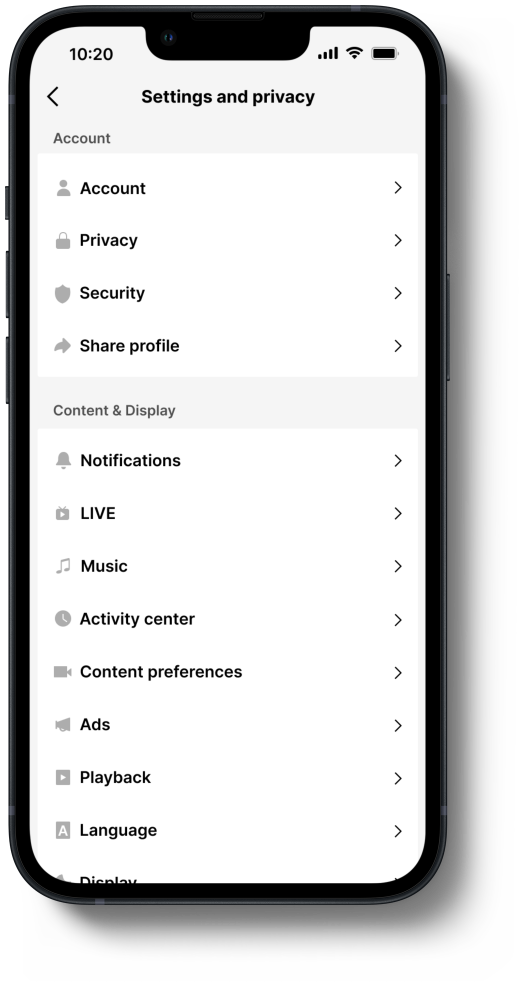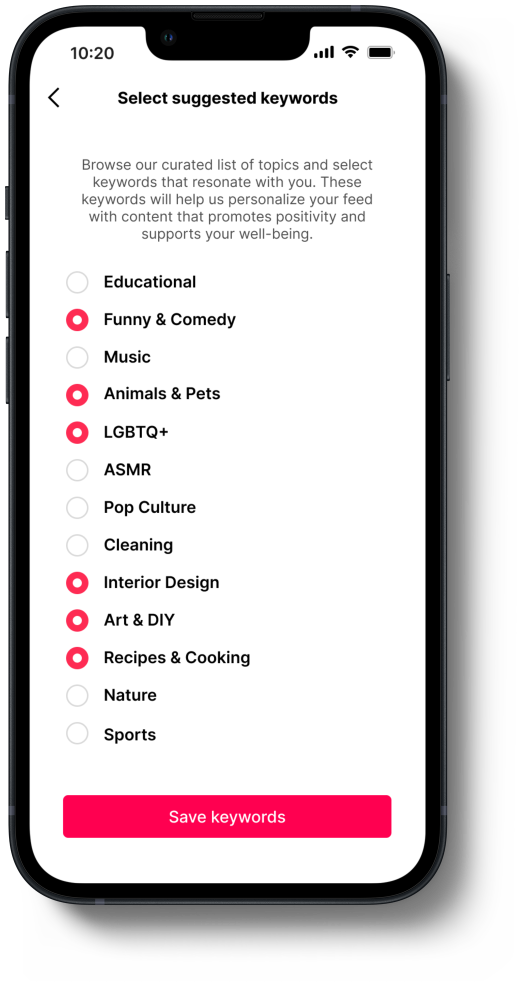
Happy Feed
Control your content and promote positivity with the TikTok
People love to use TikTok! But TikTok can inadvertently expose users to content that may be detrimental to their mental health.
TikTok's vast user base and diverse content have made it a cultural phenomenon that has skyrocketed in popularity in recent years. However, research consistently links excessive TikTok and social media use to negative mental health outcomes. TikTok's current content filtering tools, while helpful, are reactive rather than proactive when it comes to protecting your mental state.









The TikTok Happy Feed is a curated content stream within TikTok designed to promote positive mental health and happiness, rather than stress and anxiety. By filtering out potentially harmful content and prioritizing uplifting videos, the Happy Feed aims to proactively create a safe and supportive online space for users.
Learn more about my design process below!
Discovery Phase 🔍
Discovery Phase 🔍
To better understand the problem space, I learned more about social media usage and its impact on mental health through peer-reviewed research. Then, I learned what safeguard features key competitors use to protect their users. Lastly, I conducted user interviews to learn about people’s motivations, routines, and emotional responses when using TikTok. Here is what I found:
TikTok has a complicated impact on its users
🧠 Mental Health Implications: TikTok can be a double-edged sword, offering both positive and negative mental health outcomes.
✖️ Algorithmic Challenges: The platform's algorithm can inadvertently expose users to harmful content.
😟 User Vulnerability: Users are susceptible to rapid mood swings due to the unpredictable nature of the content.
1
People desire positivity and control
🌱 Positive Content: Users value uplifting and engaging content.
💪🏾 Control Over Experience: Users seek greater control over the type of content they encounter.
⭐ Mental Well-being: Users prioritize their mental health and recognize the impact of social media on their well-being.
There are limitations to existing solutions
⚡ Reactive vs. Proactive: Current content filtering tools primarily address issues after exposure, not prevention.
❓ User Experience Challenges: Users find existing safeguards difficult to discover and utilize.
2
3
Define & Design Phase ✏️
Define & Design Phase ✏️
With greater knowledge of the pain points around TikTok usage and its impact on mental health, I defined the target user, brainstormed a solution to the problem, and problem solved on where this new feature would be located in the app.
With a target user in mind and research to back me, I then asked:
How might we help users customize their TikTok content and experience based on their sensitivities and preferences?
What & Why: Now that I had developed a greater understanding of the problem space and user needs, it was time to start my initial brainstorming. After reviewing my research, pain points, persona, and HMW, I narrowed down a short list of what and why this feature needed to be.
Where: After careful consideration of user workflows and existing feature placements within TikTok, I strategically chose Content Preferences in the settings as the home for this new feature. This decision prioritizes user familiarity and fosters intuitive engagement. Below, the new feature is indicated in purple.
At this point in the project, I was still referring to this feature as the “mental health feed”. I have included the flow depicting the setup of this new feature, but here you can see the specific flow for adding video keywords to the mental health feed, and here you can see how to select and add suggested keywords to the mental health feed, after the initial setup.
Intro to new feature and initial setup
Bring it to Life ✨
Bring it to Life ✨
Now that I had decided what, where, and why to add this feature, it was time to add in the visual elements needed to bring it to life!
Here are screens that depict where I was including this new feature into existing screens. The new feature is indicated in green.
Content Preferences
Allows users to follow a familiar pattern when setting up or editing their mental health feed.
Home Screen
Users will see a new feed to the right of their For You (home) feed, keeping it easily accessible. This also keeps in mind that when people might not be in the best headspace, they need an easy solution to access positive content.
The name “Happy feed” emerged as more inviting and inclusive. Since this feed is intended to help users take a proactive approach to consuming positive content (rather than solely focusing on mental health-related content), Happy feed felt like the right name, and I used it in my high-fi wireframes.
Continuation of the project and collaboration with colleagues led me to change the name to “Happy feed” as I moved on to High Fidelity screens.
Text overlay screen
Content Preferences
I elevated the Happy feed in the Content Preferences menu to promote discoverability, for easier access, and to encourage exploration alongside the similar STEM feed.
Home Screen
Through Usability Testing I explored how users engage with the Happy feed feature and its potential for future iterations. My findings reaffirmed the strength of my prototype’s core design. It was received positively by participants, and all users were able to complete usability testing tasks regardless of their familiarity with TikTok. Users requested the addition of more categories, such as sports.
Increased opacity of the labels of each feed
Addition of a “Sports” category to Select suggested keywords
Impact of the Happy Feed
Improved User Well-being
The Happy Feed directly addresses the negative mental health impacts associated with traditional social media platforms by curating a positive and supportive environment.
1
Empowered Users
By providing users with greater control over their content consumption, the Happy Feed empowers individuals to prioritize their mental health.
2
Industry Innovation
The Happy Feed represents a step forward in the evolution of social media platforms, demonstrating a commitment to user well-being and ethical design.















